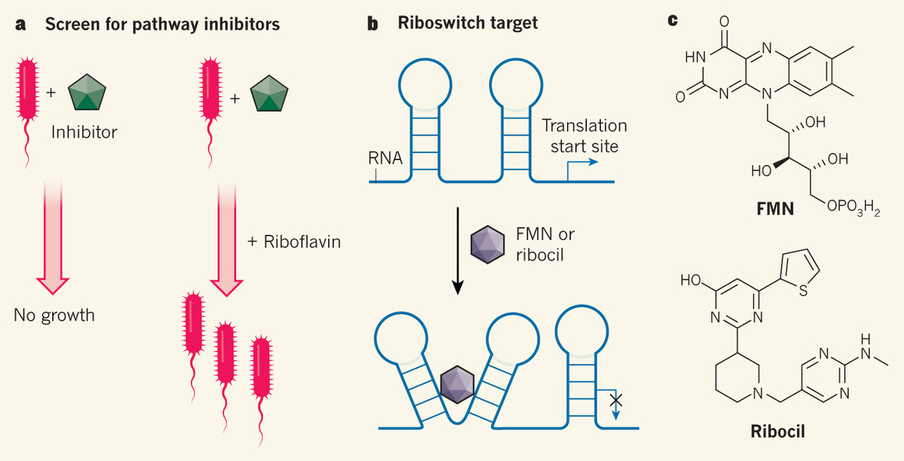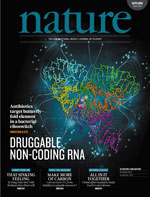The golden age of antibiotic discovery, between 1940 and 1960, was heralded by the work of Selman Waksman. A biochemist and microbiologist, Waksman coined the term 'antibiotic' and was the first to use systematic screening to discover antibacterial leads. Efforts in his laboratory yielded more than 20 natural antibiotics — most notably streptomycin in 1943, the first effective treatment for tuberculosis. The discovery won Waksman the 1952 Nobel Prize in Physiology or Medicine. Waksman's research caught the attention of scientists at the US pharmaceutical company Merck, and the ensuing collaboration was instrumental in developing streptomycin for clinical use. On page 672 of [the 29 October 2015 issue of Nature], Howe et al. from the research laboratories of the present Merck describe a new antibiotic lead, identified using a sophisticated refinement of the phenotypic-screening approach introduced by Waksman.
Seven decades after Waksman's research, the flood of antibiotics emerging from natural sources has dwindled to a trickle, and, for various reasons4, few companies remain active in antibiotic drug discovery. This is despite an urgent clinical need for new agents in the face of rising resistance to existing antibiotics. On this background, Howe and colleagues' surprising discovery of a drug target in a bacterial non-coding RNA (ncRNA) provides a welcome bright spot. MORE
Note: X-ray diffraction data for this study were collected at the Industrial Macromolecular Crystallography Association (IMCA-CAT) 17-ID-B beamline at the U.S. Department of Energy’s Argonne Advanced Photon Source (APS). The APS is an Office of Science user facility.
See: Jo
hn A. Howe, Hao Wang, Thierry O. Fischmann, Carl J. Balibar, Li Xiao, Andrew M. Galgoci, Juliana C. Malinverni, Todd Mayhood, Artjohn Villafania, Ali Nahvi, Nicholas Murgolo, Christopher M. Barbieri, Paul A. Mann, Donna Carr, Ellen Xia, Paul Zuck, Dan Riley, Ronald E. Painter, Scott S. Walker, Brad Sherborne, Reynalda de Jesus, Weidong Pan, Michael A. Plotkin, Jin Wu, Diane Rindgen, John Cummings, Charles G. Garlisi, Rumin Zhang, Payal R. Sheth, Charles J. Gill, Haifeng Tang, and Terry Roemer*, “Selective small-molecule inhibition of an RNA structural element,” Nature 526, 672 (29 October 2015). DOI: 10.1038/nature15542
Author affiliation: Merck Research Laboratories
Correspondence: *[email protected]
Use of the IMCA-CAT beamline 17-ID (or 17-BM) at the APS was supported by the companies of the Industrial Macromolecular Crystallography Association through a contract with Hauptman-Woodward Medical Research Institute. This research used resources of the Advanced Photon Source, a U.S. Department of Energy (DOE) Office of Science User Facility operated for the DOE Office of Science by Argonne National Laboratory (DE-AC02-06CH11357). L.E.W. is a Cancer Institute NSW Early Career Fellow.
The Nature cover and the excerpt from Nature News & Views © 2016 Macmillan Publishers Limited. All Rights Reserved
Argonne National Laboratory seeks solutions to pressing national problems in science and technology. The nation’s first national laboratory, Argonne conducts leading-edge basic and applied scientific research in virtually every scientific discipline. Argonne researchers work closely with researchers from hundreds of companies, universities, and federal, state and municipal agencies to help them solve their specific problems, advance America’s scientific leadership and prepare the nation for a better future. With employees from more than 60 nations, Argonne is managed by UChicago Argonne, LLC for the U.S. Department of Energy’s Office of Science.
The U.S. Department of Energy’s Office of Science is the single largest supporter of basic research in the physical sciences in the United States and is working to address some of the most pressing challenges of our time. For more information, visit the Office of Science website.


